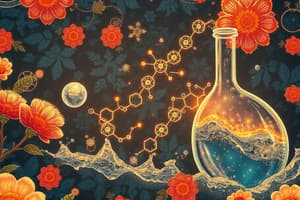Podcast
Questions and Answers
What is the primary role of water in biological systems?
What is the primary role of water in biological systems?
- Structural support
- Genetic information storage
- Energy production
- Facilitating chemical reactions (correct)
Chemical reactions always proceed at the same rate, regardless of external factors.
Chemical reactions always proceed at the same rate, regardless of external factors.
False (B)
What are the two main components of a chemical reaction?
What are the two main components of a chemical reaction?
Reactants and products
The ______ of a solution refers to its concentration of hydrogen ions.
The ______ of a solution refers to its concentration of hydrogen ions.
Match the following terms with their definitions:
Match the following terms with their definitions:
Which of these molecules are attracted to water?
Which of these molecules are attracted to water?
A solution with a pH of 3 is more acidic than a solution with a pH of 5.
A solution with a pH of 3 is more acidic than a solution with a pH of 5.
What is the primary reason water is essential for cellular processes?
What is the primary reason water is essential for cellular processes?
The process of adding salt to water involves water molecules pulling apart the ______ in the salt crystal.
The process of adding salt to water involves water molecules pulling apart the ______ in the salt crystal.
Match the following functional groups with their properties:
Match the following functional groups with their properties:
Which of these is NOT a function of water in biological systems?
Which of these is NOT a function of water in biological systems?
A buffer solution can only neutralize acids.
A buffer solution can only neutralize acids.
Why is carbon considered the backbone of organic molecules?
Why is carbon considered the backbone of organic molecules?
The ______ of water are responsible for its ability to dissolve ionic compounds.
The ______ of water are responsible for its ability to dissolve ionic compounds.
What type of bond is primarily responsible for water's unique properties?
What type of bond is primarily responsible for water's unique properties?
Flashcards
Chemical Reactions
Chemical Reactions
Processes where reactants transform into products, often in water.
Properties of Water
Properties of Water
Unique traits of water due to its molecular structure and hydrogen bonding.
States of Water
States of Water
Water exists as liquid, solid, and gas, serving various biological roles.
Acids and Bases
Acids and Bases
Signup and view all the flashcards
pH Scale
pH Scale
Signup and view all the flashcards
Importance of pH
Importance of pH
Signup and view all the flashcards
Buffers
Buffers
Signup and view all the flashcards
Carbon and Organic Molecules
Carbon and Organic Molecules
Signup and view all the flashcards
Water Polarity
Water Polarity
Signup and view all the flashcards
Hydrophilic Molecules
Hydrophilic Molecules
Signup and view all the flashcards
Hydrophobic Molecules
Hydrophobic Molecules
Signup and view all the flashcards
Amphipathic Molecules
Amphipathic Molecules
Signup and view all the flashcards
Acids
Acids
Signup and view all the flashcards
Bases
Bases
Signup and view all the flashcards
Carbon Backbone
Carbon Backbone
Signup and view all the flashcards
Functional Groups
Functional Groups
Signup and view all the flashcards
Study Notes
Chemical Reactions and Water
- Chemical reactions involve reactants transforming into products.
- These reactions often occur in watery environments, crucial for life processes.
- Reactions usually need energy and often involve enzymes.
- Reactions tend towards equilibrium but external factors can influence them.
- Water is the most abundant molecule in cells, enabling chemical reactions.
Properties of Water
- Water is a polar molecule, allowing it to dissolve ionic and polar substances.
- Hydrophilic molecules interact with water, while hydrophobic molecules repel it.
- Amphipathic molecules have both hydrophilic and hydrophobic parts.
- Water's polarity and hydrogen bonds let it dissolve substances.
- When salt dissolves in water, water molecules pull apart the ions.
States and Functions of Water
- Water exists in solid, liquid, and gaseous states, with liquid water being most common.
- Hydrogen bonds require significant energy to break, affecting water's thermal properties.
- Water provides structural support, aids waste removal, and regulates temperature.
Acids, Bases, and pH
- Acids release hydrogen ions, increasing their concentration in a solution.
- Bases reduce hydrogen ion concentration by binding to them.
- pH measures hydrogen ion concentration, inversely related to concentration.
pH Scale and Hydrogen Ion Concentration
- Pure water's neutral pH is 7.
- The pH scale is logarithmic, with each unit change representing a tenfold change in hydrogen ion concentration.
- Acidic solutions have a pH less than 7, basic solutions greater than 7.
Importance of pH in Biological Systems
- pH affects cellular processes and enzyme activity.
- Homeostatic mechanisms maintain pH within a narrow range.
- Buffers minimize pH fluctuations.
Buffers and pH Regulation
- Buffers neutralize acids or bases, minimizing pH fluctuations.
- They react to changes in hydrogen ion concentration.
- Buffers maintain stability in biological systems.
Carbon and Organic Molecules
- Carbon forms four covalent bonds, forming the backbone of complex organic molecules.
- Carbon can form both polar and non-polar covalent bonds.
Hydrocarbons and Functional Groups
- Hydrocarbons are non-polar and hydrophobic.
- Functional groups determine a molecule's chemical properties.
- Examples of functional groups include hydroxyl, carboxyl, and amino groups.
Studying That Suits You
Use AI to generate personalized quizzes and flashcards to suit your learning preferences.




